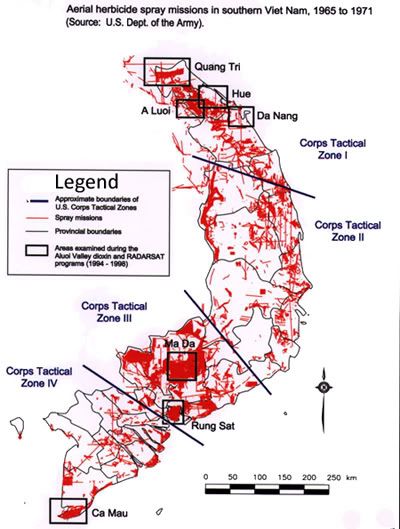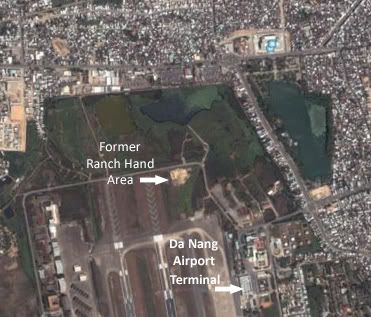(@10PM – promoted by On The Bus)
Many are aware of the decision handed down on Friday by a Federal Appeals Court in New York. The court ruled that the Vietnamese plaintiffs could not pursue claims against Dow Chemical Company, Monsanto and nearly 30 other companies for ailments caused by the use of herbicides which
the plaintiffs appealed a lower court decision that dismissed a civil suit seeking class-action status on behalf of more than 3 million Vietnamese people against the chemical companies.
The lawsuit contended that agent orange caused ailments, including birth defects and cancer.
The United States has maintained there is no scientifically proved link between the wartime spraying of herbicides and the claims of dioxin poisoning by more than 3 million people in Vietnam.
By 1983, 9170 veterans had filed claims for disabilities that they said were caused by Agent Orange. The VA denied compensation to 7709, saying that a facial rash was the only disease associated with exposure.
 According to Wikipedia, Agent Orange was used in South Vietnam and, according to the map, some areas in eastern Laos, from 1961 to 1971. Degradation of Agent Orange (as well as Agents Purple, Pink, and Green) released dioxins, which have caused health problems for those exposed during the Vietnam War.
According to Wikipedia, Agent Orange was used in South Vietnam and, according to the map, some areas in eastern Laos, from 1961 to 1971. Degradation of Agent Orange (as well as Agents Purple, Pink, and Green) released dioxins, which have caused health problems for those exposed during the Vietnam War.
What we know about dioxins
The first reported industrial dioxin poisoning occurred in Nitro, West Virginia in 1949. The exposed workers complained of rash, nausea, headaches, muscle aches, fatigue and emotional instability. A 1953 accident elsewhere resulted in peripheral neuropathies.
A 1969 report commissioned by the USDA found Agent Orange showed a
“significant potential to increase birth defects.” The same year, the NIH confirmed that it caused malformations and stillbirths in mice. In 1970, the US Surgeon General warned it might be hazardous to “our health.” The same day, the Secretaries of the Departments of Agriculture, the Interior, and HEW jointly announced the suspension of its use around lakes, recreation areas, homes and crops intended for human consumption. DOD simultaneously announced its suspension of all uses of Agent Orange.A 1979 study published in the JAMA by Bogen et al looked at 78 Vietnam veterans who reported Agent Orange exposures. Eighty percent reported extreme fatigue. Over 60% had peripheral neuropathies, 73% had depression, and 8% had attempted suicide. Forty-five per cent reported violent rages. Sudden lapses of memory were seen in 21%.
Source
– an excellent source of additional information on Agent Orange –
In Vietnam today there are several known dioxin “hotspots”. Among them is one located at the former US Airbase in Da Nang, now the Da Nang International Airport, another in the heavily sprayed region of the A Shau Valley and another at Bien Hoa.
 At Da Nang The area highly contaminated with dioxin is about 4-5 hectares in size. This is near the former transient facility for American personnel arriving and departing from Viet Nam during the war years and not far from the new airport terminal building.
At Da Nang The area highly contaminated with dioxin is about 4-5 hectares in size. This is near the former transient facility for American personnel arriving and departing from Viet Nam during the war years and not far from the new airport terminal building.
Information from Vietnamese scientists indicate that on the Da Nang Ranch Hand site, soil dioxin has been determined to be in the order of hundreds of thousands of pg/g dry weight, levels that are from 10 to 1,140 times higher than the critical level. The former Da Nang Ranch Hand site can clearly be seen from Google Earth. Areas nearby are heavily populated and there are ponds or small lakes nearby into which the dioxin poison has leached over the years and subsequently gotten into the food chain.
There two excellent videos, highly recommended here. Unfortunately I don’t see any way to embed them in this page. Scroll down to the Washington Post link to “Two videos on Agent Orange by Travis Fox”. It’s on the right side of the page, the fifth item from the top. These videos were made near the former airbase in Da Nang and show some of the victims and their families.
Here is a Vietnamese presentation – PDF – (in English) of the problems there by Phung Tuu Boi who is with The Center for Assistance in Nature Conservation and Community Development, Vietnam and adviser to the Vietnam Victims of Agent Orange Association (VAVA).
American veterans exposed to the defoliant agent orange have also largely been denied compensation and treatment by the VA for maladies they and their children have have suffered from. However in 1984, seven chemical companies including Dow and Monsanto agreed to settle out of court for $180 million with U.S. veterans who claimed “agent orange” caused cancer and other health problems.
Vietnam veterans from other countries have fared better.
In Australia, Canada and New Zealand, veterans obtained compensation in settlements. In 1999, South Korean veterans filed a lawsuit in the Korean courts. In January 2006, the Korean Appeal Court ordered Monsanto and Dow to pay US$62 million in compensation…
However, no Vietnamese have received compensation. It is possible that the issue might be decided by the US Supreme Court. Justice and fairness in addressing this issue should serve to remind us that living up to our values and showing basic decency is, in fact, the best way to win hearts and minds.

7 comments
Skip to comment form
here, here, and here.
Summary of issues and rulings here.
Important issue: court believes there is a difference between use of Nazi poison Zyclon B (used intentionally to kill people) and Agent Orange (which may have killed people but intended as a defoliant).
Lots of fact based rulings in this one (including finding of no demonstrable proof of link between chemical and health problems) which unfortunately doesn’t bode well for a successful Supreme Court appeal even if it decides to take it.
Sorry to say this probably looks like the end to 30 years of Agent Orange litigation.
Author
by way of Military dot com
Thanks for this TST. I can’t believe these suits are still being fought and unfortunately lost… to make matters worse, the gazillions of dollars the chemical companies have spent to defend themselves could have gone to help the victims and the ongoing cleanup. Those previous settlements are miniscule compared to the billions of dollars in earnings Dow and Monsanto make each year.
0% responsibility – 100% greed.
should be given as vigorous a defense as the NRA gives the second amendment. Juries, not judges should decide cases like this.
In the 1980s, I had the pleasure of working with a man who’d served in ‘Nam as a GroPo. At first, I had no idea why his hands — all red, eczema scarred and constantly raw — looked the way they did.
One day, he told me — and showed me the rest of his ongoing nasty, painful skin rashes were.
He showed me the sections along his forearms, where he said he used to sweep AO-soaked foliage out of the way as he walked on patrol. And he showed me his lower legs, and the curious way the raw rash stopped in nearly a clean line about halfway up his shin, but his ankles and feet were clean. “That’s where my boots ended,” he explained.
My friend Bill struggled for years upon years to get VA coverage and help for his skin problems, and was told that one day he would likely get cancer as a result.
Saddest part is he used to tell me he felt far worse for the Vietnamese, because they didn’t just walk through previously soaked jungle foliage like he did — many of them had AO dumped directly on them.
How sad, and how unacceptable, that our government refuses to take responsibility for its actions. We need to agitate, bitch, whine and complain until both the Vets and the Viets get justice in this matter. Our government needs to be held to account for its every action.